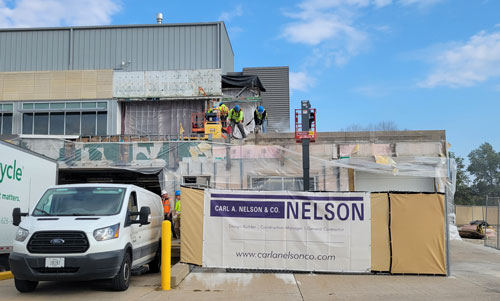CANCO leading secure laboratory project at University of Iowa
 A construction crew from Carl A. Nelson & Company (CANCO) performs exterior demolition work Oct. 11, 2022, at the University of Iowa State Hygienic Laboratory in Coralville, Iowa. CANCO is construction manager at-risk for the $9.2 million biosecurity level 3 laboratory and support space addition. CANCO photo
A construction crew from Carl A. Nelson & Company (CANCO) performs exterior demolition work Oct. 11, 2022, at the University of Iowa State Hygienic Laboratory in Coralville, Iowa. CANCO is construction manager at-risk for the $9.2 million biosecurity level 3 laboratory and support space addition. CANCO photo
2 years, 11 months ago
CORALVILLE, Iowa — Work is progressing to increase secure testing capacity at the State Hygienic Laboratory at the University of Iowa, with Carl A. Nelson & Company (CANCO) leading the $9.24 million project.
CANCO was contracted as construction manager at-risk in February 2022, following a qualifications-based selection process with competing firms. Upon conclusion of pre-construction design, value engineering and bid-letting, work began in September with partial demolition to make way for integration of the added lab and support spaces on the second floor. As CM at-Risk, CANCO is self-performing selective demolition, concrete and carpentry work, in addition to providing project management and full-time, on-site supervision.
The 7,500 SF expansion includes a new biosecurity level 3 (BSL-3) laboratory, as well as support, office and mechanical space. When complete, the facility will increase public health testing capacity at the State Hygienic Lab, which is located on UI's Oakdale Campus in Coralville. The project is being constructed with financial support from the U.S. Centers for Disease Control and Prevention. Completion is scheduled for winter 2023.
The addition marks CANCO's third major laboratory project for the University of Iowa. Previous projects include design-build construction of UI's Biomedical Research Support Facility, also on the Oakdale Campus. Working in the role of general contractor, CANCO also completed a complex vivarium fit-out and lab remodeling project in a subbasement of the Pappajohn Biomedical Discovery Building on the main campus in Iowa City.
Both projects supported medical research activities for the university, and included extensive use of BIM 3-D modeling and prefabrication of building components and mechanical systems.